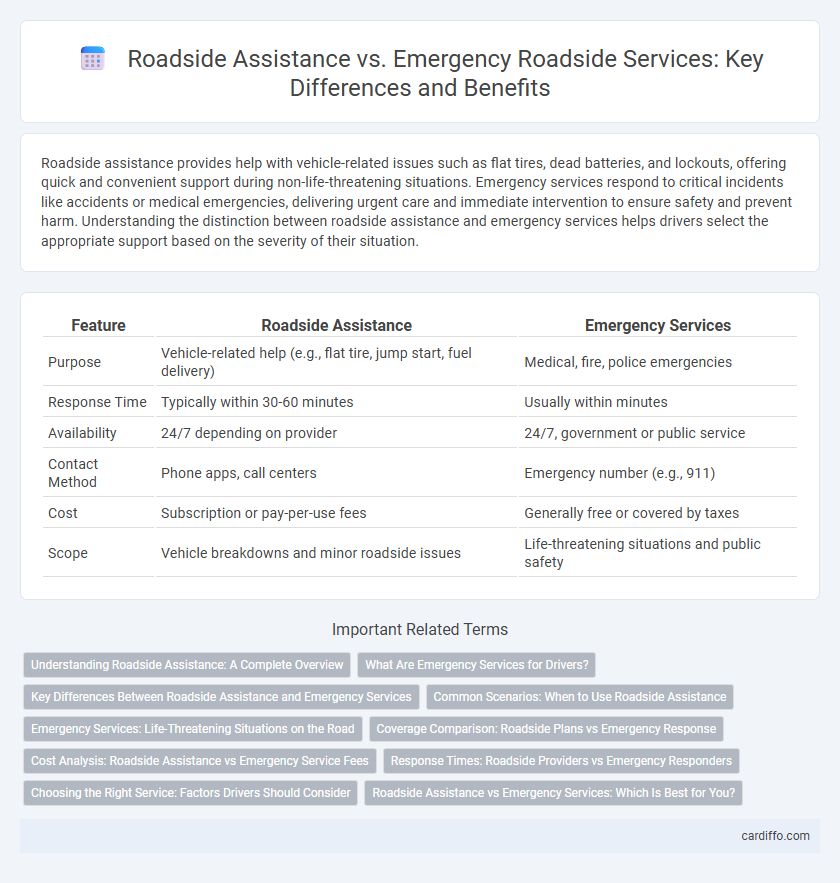Roadside assistance provides help with vehicle-related issues such as flat tires, dead batteries, and lockouts, offering quick and convenient support during non-life-threatening situations. Emergency services respond to critical incidents like accidents or medical emergencies, delivering urgent care and immediate intervention to ensure safety and prevent harm. Understanding the distinction between roadside assistance and emergency services helps drivers select the appropriate support based on the severity of their situation.
Table of Comparison
| Feature | Roadside Assistance | Emergency Services |
|---|---|---|
| Purpose | Vehicle-related help (e.g., flat tire, jump start, fuel delivery) | Medical, fire, police emergencies |
| Response Time | Typically within 30-60 minutes | Usually within minutes |
| Availability | 24/7 depending on provider | 24/7, government or public service |
| Contact Method | Phone apps, call centers | Emergency number (e.g., 911) |
| Cost | Subscription or pay-per-use fees | Generally free or covered by taxes |
| Scope | Vehicle breakdowns and minor roadside issues | Life-threatening situations and public safety |
Understanding Roadside Assistance: A Complete Overview
Roadside assistance provides non-emergency support such as tire changes, jump-starts, fuel delivery, and lockout services to drivers experiencing vehicle issues. Emergency services, on the other hand, focus on urgent medical, fire, or law enforcement response to accidents or critical situations. Understanding roadside assistance helps drivers quickly access reliable help for mechanical issues without needing emergency intervention.
What Are Emergency Services for Drivers?
Emergency services for drivers encompass specialized responders such as police, fire departments, and paramedics who provide urgent care during critical incidents like accidents, medical emergencies, or hazardous road conditions. These services focus on ensuring safety, offering medical treatment, and managing traffic to prevent further incidents. Unlike roadside assistance, which handles non-life-threatening vehicle issues, emergency services are activated during life-threatening or severe situations requiring immediate intervention.
Key Differences Between Roadside Assistance and Emergency Services
Roadside assistance primarily provides non-emergency support such as tire changes, battery jumps, and fuel delivery to stranded motorists, whereas emergency services address urgent medical, fire, and police situations requiring immediate intervention. Roadside assistance is typically offered by automotive clubs or insurance providers and does not involve life-threatening emergencies. Emergency services operate through public safety agencies equipped to handle critical incidents and ensure public safety.
Common Scenarios: When to Use Roadside Assistance
Roadside assistance is ideal for non-life-threatening vehicle issues such as flat tires, dead batteries, or lockouts, providing prompt on-site help to get drivers back on the road quickly. Emergency services are necessary when accidents cause injuries, fires, or hazardous conditions, requiring immediate medical or police intervention. Common scenarios to use roadside assistance include vehicle breakdowns, fuel delivery needs, or towing requests due to mechanical failure.
Emergency Services: Life-Threatening Situations on the Road
Emergency services provide immediate response for life-threatening situations on the road, such as severe car accidents, medical emergencies, or hazardous spills. These services include ambulance dispatch, fire rescue, and police intervention to ensure safety and rapid care. Roadside assistance primarily addresses non-urgent vehicle issues like flat tires or battery jumps, whereas emergency services prioritize critical, time-sensitive incidents requiring specialized medical or rescue expertise.
Coverage Comparison: Roadside Plans vs Emergency Response
Roadside assistance plans typically cover services such as towing, tire changes, fuel delivery, and battery jump-starts, offering protection mainly for vehicle-related issues. Emergency response services provide medical aid, fire rescue, police intervention, and evacuation support, addressing life-threatening and safety-critical situations. Comparing coverage, roadside plans focus on vehicle immobilization incidents, while emergency services cover broader public safety and health emergencies.
Cost Analysis: Roadside Assistance vs Emergency Service Fees
Roadside assistance typically offers lower and more predictable fees compared to emergency services, which often involve higher costs due to urgent medical, fire, or police interventions. Emergency service fees can escalate quickly because of specialized personnel, equipment, and immediate response requirements, whereas roadside assistance mainly covers towing, tire changes, or battery boosts at a fixed or subscription-based rate. Choosing roadside assistance over emergency services can significantly reduce out-of-pocket expenses for vehicle-related issues that do not require urgent medical or law enforcement intervention.
Response Times: Roadside Providers vs Emergency Responders
Roadside assistance providers typically offer faster response times for vehicle-related issues such as tire changes, fuel delivery, or lockouts, often arriving within 30 to 60 minutes. Emergency services, including police, fire, and medical responders, prioritize life-threatening situations and may take longer to reach non-critical automotive incidents due to their broader scope and dispatch protocols. Comparing averages, roadside assistance response times are usually quicker for minor emergencies, while emergency responders focus on urgent medical or safety threats, impacting overall arrival speed.
Choosing the Right Service: Factors Drivers Should Consider
Drivers should evaluate the nature and urgency of their situation when choosing between roadside assistance and emergency services, prioritizing safety and response time. Roadside assistance is suitable for non-life-threatening issues like flat tires or dead batteries, while emergency services address critical incidents requiring immediate medical or safety intervention. Considering factors such as location, severity, and available resources ensures an appropriate and efficient response to the roadside incident.
Roadside Assistance vs Emergency Services: Which Is Best for You?
Roadside assistance provides non-emergency help such as tire changes, battery jumps, and fuel delivery, making it ideal for minor vehicular issues that don't require urgent medical or safety intervention. Emergency services, including police, fire, and ambulance, respond to critical situations involving accidents, injuries, or hazards that demand immediate attention and professional rescue. Choosing between roadside assistance and emergency services depends on the severity of your situation, with roadside support best suited for mechanical problems and emergency services necessary for life-threatening events.
Roadside Assistance vs Emergency Services Infographic

 cardiffo.com
cardiffo.com